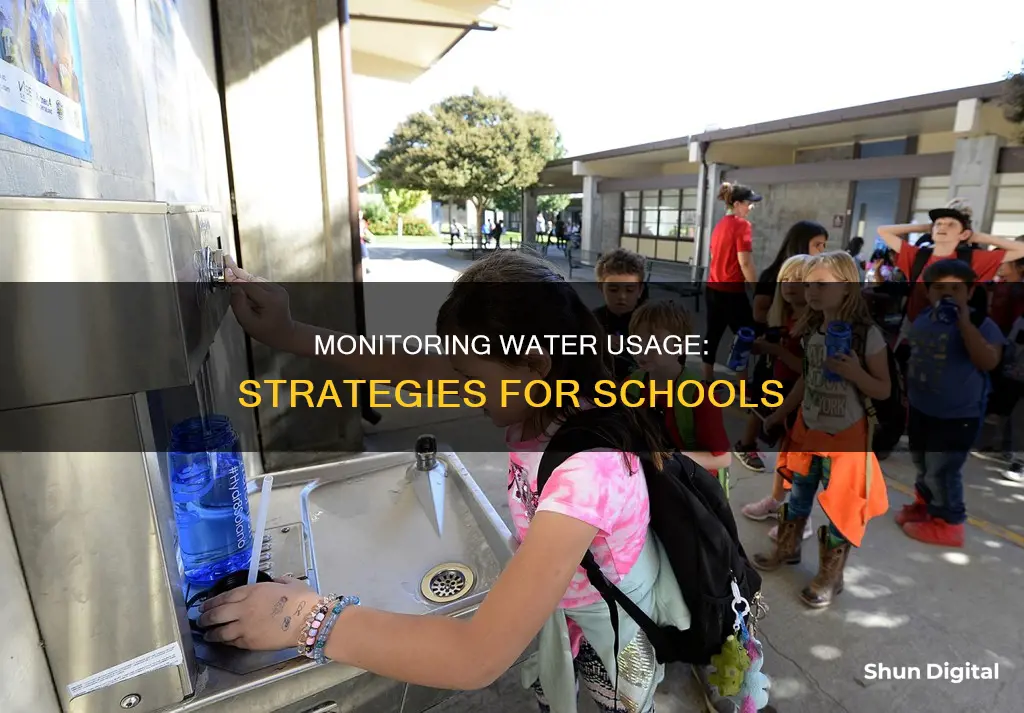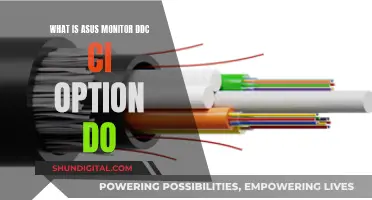
Water is a precious resource, and with increasing water scarcity, monitoring water usage is critical to ensure efficient and sustainable management. Schools, in particular, can benefit from real-time water monitoring solutions to promote conservation and cost savings. Traditional methods of manually reading mechanical water meters are often inaccurate and inefficient, lacking the ability to provide real-time data. Modern solutions, such as smart water meters and flow meters with AI-enhanced monitoring, offer a more sophisticated approach. These technologies provide detailed, real-time water usage data, helping schools identify leaks, abnormal usage, and inefficiencies promptly. Additionally, such tools enable schools to set conservation goals and receive notifications about unusual usage. By embracing these innovations, schools can play a vital role in optimizing water usage, minimizing waste, and fostering a more sustainable future.
| Characteristics | Values |
|---|---|
| Traditional water monitoring methods | Reading the mechanical water meter installed by the water utility company |
| Downsides of traditional methods | Inherent inaccuracy associated with manual readings |
| How to monitor water usage in 2024 | Smart water meters |
| Water flow meter | Sensors that send data to an AI-powered dashboard |
| Smart infrastructure | Technologically advanced pipes and valves designed to automate and optimize water flow |
| District Metering | Monitoring water flow into smaller districts |
| Advanced Metering Infrastructure (AMI) | Two-way communication between the meters and the utility company |
| Remote Sensing | Satellites and drones used to monitor water resources and infrastructure |
What You'll Learn

Using smart water meters to monitor usage in real-time
Smart water meters are the next generation of water measurement tools, offering a more sophisticated way to monitor water usage. These high-tech devices provide detailed, minute-by-minute water usage data directly to the user and the utility provider. This gives schools an effective way to monitor their water usage in real-time, helping to identify leaks and abnormal usage patterns.
Smart water meters replace outdated mechanical meters, transmitting water usage data to an online account, a smartphone app, or a web dashboard. This gives users immediate access to data, allowing them to identify unexpected spikes in usage, which could indicate leaks or inefficiencies.
Benefits of smart water meters for schools
Smart water meters offer several advantages for schools:
- Real-time data and notifications: Schools can receive instant alerts via SMS or email about leaks or abnormal usage, allowing them to take prompt corrective action.
- Improved water efficiency: With real-time data, schools can make better-informed decisions to boost water efficiency and conservation practices.
- Cost savings: By identifying and addressing leaks and inefficiencies quickly, schools can significantly reduce water wastage and lower their water bills.
- Simplified benchmarking: Smart water meters provide specific data points that simplify the process of benchmarking water usage against similar schools or facilities.
- Eligibility for credits: Some water utility companies offer sanitary sewer credits for schools that implement real-time water monitoring systems.
- Reduced manual labour: Smart water meters eliminate the need for manual meter readings, reducing the time and effort required for water usage tracking.
- Accurate billing: With precise data, schools can ensure they are being correctly billed for their water usage, avoiding overpayment.
Examples of smart water meters
- WaterSignal: WaterSignal is a non-invasive device that provides real-time monitoring and management of water usage in buildings, including schools. It helps identify uncontrolled water loss by immediately alerting users of excessive or abnormal water usage.
- Flume 2 Smart Home Water Monitor: This device can be installed in minutes and provides leak detection and water usage monitoring to help reduce water waste.
- Moen Flo Smart Water Monitor: This Wi-Fi-enabled device combines water usage monitoring with an automatic shut-off sensor to detect and prevent leaks.
- YoLink FlowSmart: This smart water meter offers real-time leak detection and comes with a hub for app-controlled usage monitoring and over 10 years of battery life.
By adopting smart water meters, schools can benefit from real-time water usage data, leading to improved water efficiency, cost savings, and better conservation practices. These devices empower schools to take a proactive approach to water management, ensuring that thousands of gallons of water aren't wasted.
Monitoring Furnace Usage: A Comprehensive Guide to Tracking Efficiency
You may want to see also

Tracking indoor vs outdoor water consumption
Understanding Water Usage Patterns
Begin by understanding the typical indoor and outdoor water usage patterns in schools. This includes identifying the specific activities and areas that contribute to water consumption. For instance, outdoor irrigation for sports fields, gardens, or playgrounds can account for a significant portion of outdoor water usage. Indoors, water usage may vary depending on the number of students and staff, the availability of water-efficient fixtures, and the presence of any water-intensive activities such as cooking or laboratory work.
Metering and Monitoring Solutions
Install advanced metering systems that can provide real-time data on indoor and outdoor water consumption. Smart water meters and flow meters with AI-enhanced monitoring capabilities can track usage patterns, detect leaks, and provide alerts for unusual consumption. These systems offer remote access to data through online dashboards, smartphone apps, or web interfaces. Additionally, consider investing in sub-meters for specific areas or activities with high water usage to gain more detailed insights.
Set Benchmarks and Targets
Analyze water consumption data from similar schools in your region to establish realistic benchmarks and targets for indoor and outdoor water usage. Compare your school's water consumption patterns with those of other schools to identify areas where improvements can be made. This will help in setting realistic goals for water conservation and identifying opportunities for optimization.
Encourage Water Conservation Practices
Promote water conservation practices among students, staff, and faculty. Educate the school community about the importance of responsible water usage and provide simple guidelines to reduce water waste. This can include fixing leaky faucets, reporting running toilets, turning off taps when not in use, and adopting water-efficient practices for cleaning, gardening, or sports field maintenance.
Regular Audits and Maintenance
Conduct regular audits and maintenance checks to identify and address any issues promptly. This includes checking for leaks, ensuring proper functioning of water fixtures, and verifying that water-using equipment is well-maintained and optimized for efficiency. Regular maintenance can help prevent water wastage, reduce costs, and extend the lifespan of plumbing infrastructure.
Engage the School Community
Involve students, staff, and parents in water conservation initiatives. Encourage student-led projects or clubs focused on water conservation, organize educational workshops, and provide feedback on the school's water conservation progress. By engaging the entire school community, you can foster a culture of environmental responsibility and empower individuals to take ownership of their water usage habits.
By implementing these strategies, schools can effectively track and manage their indoor and outdoor water consumption, contributing to sustainable water usage and cost savings.
Monitoring Internet Usage: Strategies for Parents and Guardians
You may want to see also

Setting water usage budgets
Understand Water Consumption Patterns:
Start by gathering data on the school's water usage over a period of time. Analyze historical water consumption data, including monthly or annual measurements, to establish a baseline understanding of the school's water usage. Identify any unusual spikes or fluctuations in water usage that may indicate leaks or inefficient practices. This data will be essential for setting realistic and effective water usage budgets.
Calculate a Per-Student Water Consumption Baseline:
As schools have varying student populations, calculating water consumption per student is a more accurate way to set budgets. Use the formula: Cm = Water consumption (m³/month) / Number of students x Average number of weekdays per month. This calculation will give you a baseline water consumption per student, which can be adjusted as needed.
Set Daily, Weekly, or Monthly Water Budgets:
Based on the consumption data and per-student calculations, set specific water usage budgets for the school. You can set daily, weekly, or monthly budgets, whichever works best for your school's needs and management capabilities. These budgets should aim to reduce water waste while ensuring sufficient water is available for drinking, hygiene, cleaning, and other essential purposes.
Implement Water-Saving Measures:
Once the budgets are set, work with the school's facility management and students to implement water-saving measures. This may include repairing leaks, installing water-efficient fixtures and appliances, promoting water conservation among students and staff, and exploring alternative water sources such as rainwater harvesting. Regularly review the school's water bills and consumption data to ensure the budgets are being adhered to and make adjustments as necessary.
Monitor and Adjust:
Water usage budgets should be dynamic and adaptable. Continuously monitor the school's water consumption and make adjustments to the budgets as needed. If the budgets are consistently exceeded, re-evaluate the water-saving measures and identify areas for improvement. If the budgets are consistently underspent, consider adjusting them to allocate water resources more efficiently.
By following these steps, schools can effectively set water usage budgets, promote water conservation, and ensure the efficient use of this precious resource.
Hotels and Internet Privacy: Monitoring Guest Online Activity
You may want to see also

Using AI-enhanced monitoring to predict future usage
Water flow meters are an integral part of a sophisticated water management system. These sensors go beyond simple measurement; they collect data and send it to an AI-powered dashboard that can analyse it in depth. This intelligent analysis can uncover trends, predict future usage, and even suggest areas for water conservation.
AI-enhanced monitoring can provide a dynamic response to water usage patterns, making adjustments to ensure optimal efficiency. For example, it can inform AI developers and help them decide where and when to train and deploy AI models. By monitoring water usage, AI can enable flexible performance trade-offs between a model's accuracy and water consumption. If an AI model is deployed in a water-stressed area, it may be more prudent to use a compact model with a smaller water footprint.
AI-enhanced monitoring can also help schools identify areas of high water usage and wastage. This can be especially useful for schools in water-stressed areas or those with limited access to potable water. By understanding water usage patterns, schools can develop targeted water conservation plans and educate students, teachers, and staff about conscious water use and conservation efforts.
Additionally, AI-enhanced monitoring can assist in leak detection. Water leaks can lead to significant water wastage and property damage if not addressed promptly. With real-time data and notifications, schools can quickly identify and address leaks, reducing water wastage and preventing potential damage to school infrastructure.
Overall, AI-enhanced monitoring of water usage in schools can lead to more efficient water management, helping to conserve this vital resource and ensure its availability for future generations.
Monitoring Data Usage: Net10 Mobile Hotspot Guide
You may want to see also

Monitoring water flow into different areas of the school
Monitoring water flow into different areas of a school is essential for several reasons. Firstly, it helps identify areas of high water consumption, enabling the school to target water conservation efforts effectively. Secondly, it allows for the detection of leaks or abnormal water usage patterns, which can result in significant water wastage and property damage if left unchecked. Finally, real-time water flow data provides valuable insights for stakeholders, helping to make informed decisions about water management and cost allocation.
To effectively monitor water flow into different areas of the school, the following steps can be taken:
- Install Advanced Water Meters: Install smart water meters at various points across the school premises, including areas with high-value assets such as athletic complexes, computer labs, and libraries. These meters should be able to transmit real-time data on water usage to a central system, allowing for remote monitoring.
- Set Up Alerts: Utilize the features provided by the water monitoring system to set up alerts for unusual water usage. These alerts can be in the form of SMS, email, or push notifications, ensuring that the relevant personnel are promptly notified of any potential issues.
- Break Down Water Usage by Area: Analyze water flow data by specific areas or departments within the school. This helps identify which parts of the school are using the most water and may benefit from water-saving initiatives or infrastructure upgrades.
- Compare Data Over Time: Compare water flow data over different periods to identify trends and anomalies. For example, there may be seasonal variations in water usage, or specific events that result in spikes in consumption. This information can help the school optimize its water usage patterns and prepare for future fluctuations.
- Involve Stakeholders: Share the water flow data and reports with all relevant stakeholders, including facility managers, sustainability directors, and the school administration. This promotes transparency and enables collaborative decision-making to reduce water wastage and costs.
- Implement Water Conservation Measures: Based on the insights gained from monitoring water flow, implement targeted water conservation measures. This could include repairing leaks, replacing old fixtures with water-efficient alternatives, or raising awareness among students and staff about responsible water usage.
By following these steps, schools can effectively monitor water flow into different areas, identify inefficiencies, and promote sustainable water usage practices, ultimately reducing costs and minimizing the risk of water damage.
Monitoring Bandwidth Usage on Your iPad: A Step-by-Step Guide
You may want to see also
Frequently asked questions
There are several methods and technologies available to monitor water usage in schools. One way is to install a smart water meter, which provides detailed water usage data directly to the utility provider and the consumer in real time. Another option is to use a water flow meter with AI-enhanced monitoring, which can uncover trends, predict future usage, and suggest areas for water conservation. Additionally, you can use a device like WaterSignal, which tracks water usage in real time and helps improve water efficiency in schools.
Monitoring water usage in schools can help identify potential leaks or inefficiencies, pave the way for a more sustainable future, and provide valuable insights into usage patterns. It can also help schools save money on water bills and prevent infrastructure damage caused by water leaks.
One challenge is the manual and rudimentary process of traditional water monitoring methods, which can be inaccurate and inefficient. Additionally, the lack of real-time data in conventional meters can make it difficult to promptly identify and address issues such as leaks or unexpected spikes in water usage.







